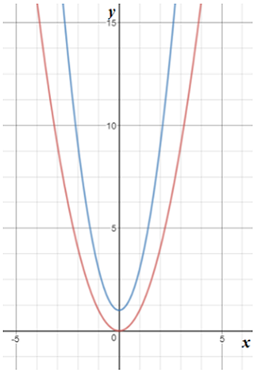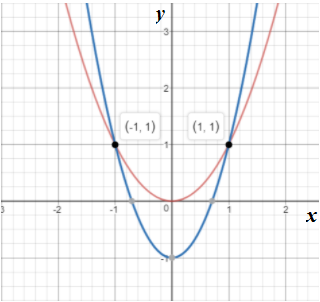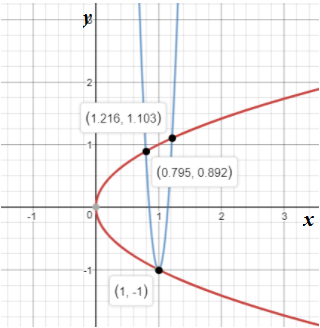
To determine: The description of the possible solutions of a system consisting of two
Answer to Problem 1E
The possible solutions of a system consisting of two quadratic equations may be 0, 1, 2, 3 or 4.
Explanation of Solution
The graphs of two quadratic equations in different ways are shown below:
Graph 1:

In the above graph, it is seen that the two equations have not intersected each other at any point. This means the system of equations have no solution.
Graph 2:

In the above graph it is seen that two equations intersect each other at only one point. This means the system of equations has only one solution.
Graph 3:

In the above graph it is seen that the two equations have intersected each other at two points. This means the system of equations has 2 solutions.
Graph 4:

In the above graph, it is seen that the two equations have intersected each other at three points. This means the system of equations has 3 solutions.
Graph 5:

In the above graph, it is seen that the two equations have intersected each other at four points. This means the system of equations has 4 solutions.
Hence, the possible solutions of a system consisting of two quadratic equations may be 0, 1, 2, 3 or 4.
Chapter 3 Solutions
Big Ideas Math A Bridge To Success Algebra 2: Student Edition 2015
 Algebra and Trigonometry (6th Edition)AlgebraISBN:9780134463216Author:Robert F. BlitzerPublisher:PEARSON
Algebra and Trigonometry (6th Edition)AlgebraISBN:9780134463216Author:Robert F. BlitzerPublisher:PEARSON Contemporary Abstract AlgebraAlgebraISBN:9781305657960Author:Joseph GallianPublisher:Cengage Learning
Contemporary Abstract AlgebraAlgebraISBN:9781305657960Author:Joseph GallianPublisher:Cengage Learning Linear Algebra: A Modern IntroductionAlgebraISBN:9781285463247Author:David PoolePublisher:Cengage Learning
Linear Algebra: A Modern IntroductionAlgebraISBN:9781285463247Author:David PoolePublisher:Cengage Learning Algebra And Trigonometry (11th Edition)AlgebraISBN:9780135163078Author:Michael SullivanPublisher:PEARSON
Algebra And Trigonometry (11th Edition)AlgebraISBN:9780135163078Author:Michael SullivanPublisher:PEARSON Introduction to Linear Algebra, Fifth EditionAlgebraISBN:9780980232776Author:Gilbert StrangPublisher:Wellesley-Cambridge Press
Introduction to Linear Algebra, Fifth EditionAlgebraISBN:9780980232776Author:Gilbert StrangPublisher:Wellesley-Cambridge Press College Algebra (Collegiate Math)AlgebraISBN:9780077836344Author:Julie Miller, Donna GerkenPublisher:McGraw-Hill Education
College Algebra (Collegiate Math)AlgebraISBN:9780077836344Author:Julie Miller, Donna GerkenPublisher:McGraw-Hill Education





